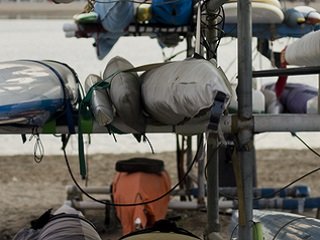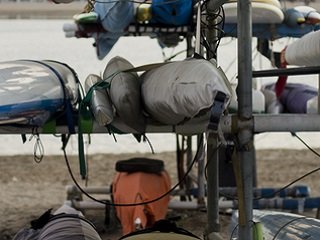 In Parts One and Two of our series on kayak storage, we explored how to protect your kayak from the elements, as well as the importance of distributing its weight evenly when not in use. Today, we’ll finish up the series by highlighting some steps you can take to keep your kayak from being stolen.
In Parts One and Two of our series on kayak storage, we explored how to protect your kayak from the elements, as well as the importance of distributing its weight evenly when not in use. Today, we’ll finish up the series by highlighting some steps you can take to keep your kayak from being stolen.
As we’ve discussed, you’ll always want to store your kayak indoors, if possible. This means in a garage or even in your house, if you have the space. However, if such space isn’t available, and you have to keep it outside where it’s more exposed to thieves, then there are some measures you can take.
First, try to keep your kayak out of sight as best as you can. If people can’t see it, then they won’t know it’s there, right? Covering your kayak with a tarp or fitting it between other things, such as pieces of farm equipment or vehicles, will help.
Also, try to keep it stored and positioned in a way that makes it difficult for any potential thieves to quickly grab it and take off. Kayaks are big enough to be carried by single individual, but storing it atop a shed or other high place where more work is required to get it down may help deter theft.
Another great way to keep someone from stealing your kayak is to make it less appealing. All this takes is adding extra identification, which advertises that it has been marked for identification. Manufacturers typically place a hull identification number (HIN) on their kayaks, which distinguishes one boat from another. This twelve character letter/number combination is usually enough to keep the smarter thieves away, but adding a few more modes of identification here (your name or even your driver’s license number) or there tells people that you have the means of locating your kayak if it’s stolen.
Finally, if you have no secure place to store your kayak, I suggest simply threading a durable security cable through a sturdy part of the boat, such as a wire grab loop, and locking it to a post, fence or building. There are several different kayak cables available these days, so you shouldn’t have any trouble picking some up.
Our outdoor gear keeps us safe and comfortable while we enjoy the trails and rivers, so it’s important that we return the favor, especially when we’re not using it. Storing your kayak properly can help maintain its structural integrity, as well as keep it from being stolen. Take the time to do this and you’ll be able to enjoy your kayak for several years!








